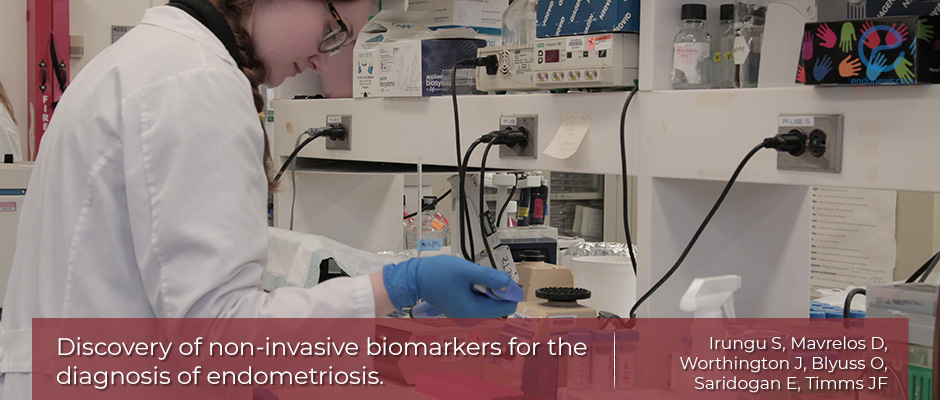Non‑invasive biomarkers for endometriosis diagnosis
Jun 4, 2019
The combination of biomarkers may provide diagnostic accuracy for endometriosis and clinical utility to determine the triage of patients for surgery.
Key Points
Highlights:
- The combined use of "ICAM1, FST, estradiol" in the proliferative phase, and "CA125, MIF, PAEP" in the secretory phase improves the diagnostic accuracy for endometriosis.
Importance:
- The use of non-invasive biomarkers in the diagnosis may prevent delays in the diagnosis and treatment of endometriosis. The identification of biomarkers is urgently required for effective and early management, and improvement of the quality of life.
What’s done here?
- This retrospective case-control biomarker discovery and validation study was conducted in the University College London Hospital, Department of Gynecology.
- Women referred for the investigation of pelvic pain, for diagnosis and treatment of endometriosis, and then agreed to undergo laparoscopic surgery, were included; “endometriosis”, “controls with pain” and “controls without pain” groups were identified.
- A triple approach (chronological & histological dating, and sex steroid hormone determination) was used to determine the cycle phase. Eutopic and ectopic endometrial tissue samples were collected.
- Proteomic analysis by liquid chromatography-mass spectrometry/mass spectrometry was used for protein identification in tissue samples.
- Selected differentially expressed candidate markers (LUM, TPM2, CPM, PAEP, TNC), and promising candidate markers reported in the literature (CA125, sICAM1, MCP1, MIF, IL1R2, VEGF, FST) were tested using ELISA kits to identify an effective non-invasive biomarker for the diagnosis of endometriosis.
- The diagnostic performance of each biomarker was statistically determined.
Key results:
- A total of 87 women who met the criteria were included in the study: “endometriosis cases” group (45), “controls with pain” group (21) and “controls without pain” group (21).
- Numerous muscle-related proteins were highly expressed in ectopic vs eutopic endometrial tissues suggesting the presence of significant amounts of muscle tissue in ectopic sites.
- A variety of extracellular matrix proteins were also expressed in higher amounts in the ectopic endometrial tissues.
- From tissue profiling, some serological markers TNC, CPM, TPM2, LUM, and PAEP underwent further testing.
- The best single marker for discriminating endometriosis from controls remained CA125.
- To detect endometriosis, the best cross-validated multimarker model is the combination of ICAM1, FST, estradiol for the proliferative phase, and the combination of CA125, MIF, PAEP for the secretory phase.
Limitations
- Retrospective design, and reduced power due to testing the models by cross-validation and subgrouping by cycle phase.
- The low sensitivity (67%) and specificity (80%) of the selected biomarkers are debatable for their usage as a triage test, and the cycle-phase subgrouping may be difficult for clinical utility.
Lay Summary
Endometriosis is a disease of women in reproductive age and its incidence varies between 5-10%. Since the diagnosis is based on the histological confirmation, there is an average of 7 to 11 years of delays in the diagnosis.
Promising non-invasive biomarkers are needed for early diagnosis and treatment of endometriosis. However, there is no biomarker with high sensitivity and specificity that has been validated in the diagnosis of endometriosis to take place in clinical use.
Irungu et al, a group of scientists from the United Kingdom, published a study titled as “Discovery of non‑invasive biomarkers for the diagnosis of endometriosis” in the journal named as Clinical Proteomics. The authors sought to identify potential biomarkers for the clinical use of endometriosis and triage of the patients for surgery. A total of 87 women who met the criteria were included in the study, and divided into “endometriosis cases” (n=45), “controls with pain” (n=21) and “controls without pain” (n=21) groups for the evaluation of proteomic profiling.
The authors found that the combination of ICAM1, FST, and estradiol in the proliferative phase and the combination of CA125, MIF, and PAEP in the secretory phase had the highest diagnostic accuracy for endometriosis; but their use alone is not supported as diagnostic markers. The authors also suggested that validation studies of these models in a larger independent cohort with other gynecological conditions presenting with similar symptoms to allow better assessment of their specificity. CA125 was identified as the best single marker for discriminating endometriosis from controls and featured prominently in the best-performing multimarker models, it is not specific and lacks the diagnostic accuracy.
“Independent validation of these biomarker panels in a larger cohort is however warranted, and if successful, they may have clinical utility in triaging patients for surgery,” they added.
Research Source: https://www.ncbi.nlm.nih.gov/pubmed/30992697
endometriosis biomarkers eutopic endometrial tissue ectopic endometrial tissue CA125

